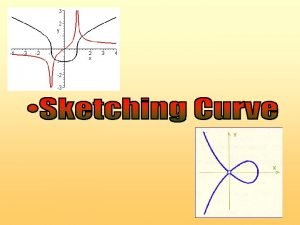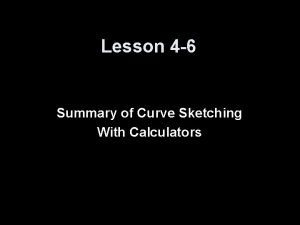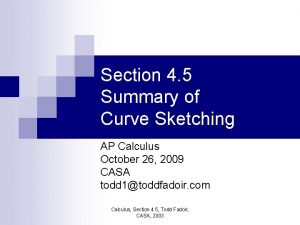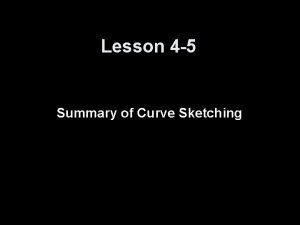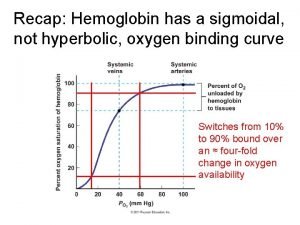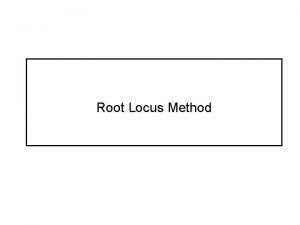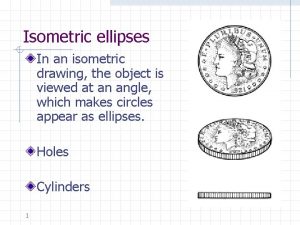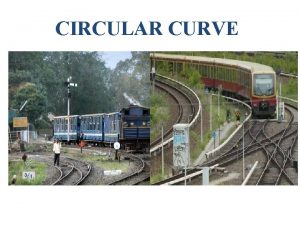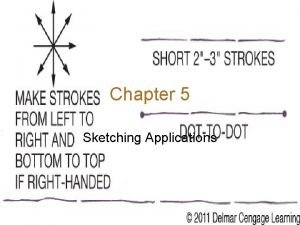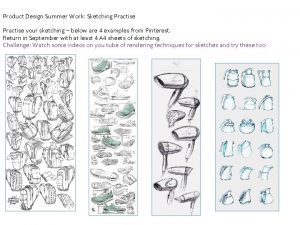Curve Sketching ALWAYS LEARNING Slide 1 ALWAYS LEARNING





































- Slides: 37

Curve Sketching ALWAYS LEARNING Slide 1

ALWAYS LEARNING Slide 2

ALWAYS LEARNING Slide 3

ALWAYS LEARNING Slide 4

ALWAYS LEARNING Slide 5

ALWAYS LEARNING Slide 6

Local maximum Local minimum ALWAYS LEARNING Slide 7

ALWAYS LEARNING Slide 8

ALWAYS LEARNING Slide 9

x 1 & x 3 are local maximums x 2 & x 4 are local minimums ALWAYS LEARNING Slide 10

ALWAYS LEARNING Slide 11

ALWAYS LEARNING Slide 12

Example: Solution: Find the critical numbers of the given function. Critical numbers are numbers in the domain of f where do not exist. We have so for every x. Setting shows that or exists Therefore − 3 and 4 are the critical numbers of f; these are the only places where local extrema could occur. The graph at the right shows that there is a local maximum at and a local minimum at ALWAYS LEARNING Slide 13

ALWAYS LEARNING Slide 14

ALWAYS LEARNING Slide 15

ALWAYS LEARNING Slide 16

Example: Find the second derivative of the given function. (a) Solution: Here, of ALWAYS LEARNING The second derivative is the derivative Slide 17

Example: Find the second derivative of the given function. (b) Solution: Use the quotient rule to find Use the quotient rule again to find ALWAYS LEARNING Slide 18

Example: Find the second derivative of the given function. (c) Solution: Using the product rule gives Differentiate this result to get ALWAYS LEARNING Slide 19

ALWAYS LEARNING Slide 20

ALWAYS LEARNING Slide 21

ALWAYS LEARNING Slide 22

ALWAYS LEARNING Slide 23

ALWAYS LEARNING Slide 24

ALWAYS LEARNING Slide 25

ALWAYS LEARNING Slide 26

ALWAYS LEARNING Slide 27

ALWAYS LEARNING Slide 28

ALWAYS LEARNING Slide 29

Continued on next slide ALWAYS LEARNING Slide 30

Continued from previous slide ALWAYS LEARNING Slide 31

Example: Graph Solution: Step 1 The y-intercept is Step 2 To find the x-intercepts, we must solve the equation Step 3 There is no easy way to do this by hand, so skip this step. Since f(x) is a polynomial function, the graph has no asymptotes, so we can also skip Step 3. Step 4 The first derivative is Step 5 The first derivative is defined for all x, so the only critical numbers are the solutions of and the second Divide both sides by 6. Factor. ALWAYS LEARNING Slide 32

Example: Graph Solution: Step 5 Using the second-derivative test on the critical number have, Hence, there is a local maximum when Similarly, so there is a local minimum when ). we that is, at the point (at the point Next, we determine the intervals on which f is increasing or decreasing by solving the inequalities ALWAYS LEARNING Slide 33

Example: Graph Solution: Step 5 The critical numbers divide the x-axis into three regions. Testing a number from each region, as indicated below, we conclude that f is increasing on the intervals and decreasing on Figure 12. 46 Step 6 The second derivative is defined for all x, so the possible points of inflection are determined by the solutions of ALWAYS LEARNING Slide 34

Example: Graph Solution: Step 6 Determine the concavity of the graph by solving Therefore, f is concave upward on the interval and concave downward on Consequently, the only point of inflection is Step 7 Since f is a third-degree polynomial function, we know that when x is very large in absolute value, its graph must resemble the graph of its highest degree term, that is, the graph must rise sharply on the right side and fall sharply on the left. ALWAYS LEARNING Slide 35

Example: Graph Solution: Step 7 Combining this fact with the information in the preceding steps, we see that the graph of f must have the general shape shown below. ALWAYS LEARNING Slide 36

Example: Graph Solution: Step 8 Now we plot the points determined in Steps 1, 5, and 6, together with a few additional points to obtain the graph below. ALWAYS LEARNING Slide 37
 What are the basic dance steps in heel and toe polka?
What are the basic dance steps in heel and toe polka? Curve sketching examples with solutions doc
Curve sketching examples with solutions doc Curve sketching calculator
Curve sketching calculator Curve sketching ap calculus
Curve sketching ap calculus (x²+4²-1)³-x²4³=0
(x²+4²-1)³-x²4³=0 Sigmoidal and hyperbolic curve
Sigmoidal and hyperbolic curve S curve and j curve
S curve and j curve Curve of monson definition
Curve of monson definition S curve and j curve
S curve and j curve Walmart
Walmart Factoring polynomials
Factoring polynomials Exploded/cross projection sketch
Exploded/cross projection sketch Sketching vocabulary
Sketching vocabulary Crime scene rough sketch
Crime scene rough sketch What is root locus in control system
What is root locus in control system Multiview sketch definition
Multiview sketch definition Missing view problems engineering drawing
Missing view problems engineering drawing Perspective pictorial drawing
Perspective pictorial drawing Dr frost sketching quadratics
Dr frost sketching quadratics Sketching graphs of quadratic functions
Sketching graphs of quadratic functions Cubic and reciprocal graphs
Cubic and reciprocal graphs Crime scene sketch examples
Crime scene sketch examples Sketch chapter 7
Sketch chapter 7 Sketching graphs calculus
Sketching graphs calculus How to sketch a crime scene
How to sketch a crime scene Sketching as a tool for numerical linear algebra
Sketching as a tool for numerical linear algebra Basic isometric drawing
Basic isometric drawing Pltw concept sketching
Pltw concept sketching Introduction of technical drawing
Introduction of technical drawing How to read slope fields
How to read slope fields Design right
Design right Multiview sketch definition
Multiview sketch definition Multiview drawing
Multiview drawing Multi-view drawing
Multi-view drawing Isometric sketching
Isometric sketching Isometric elipse
Isometric elipse Cross projection method sketching
Cross projection method sketching Freehand sketching techniques
Freehand sketching techniques

